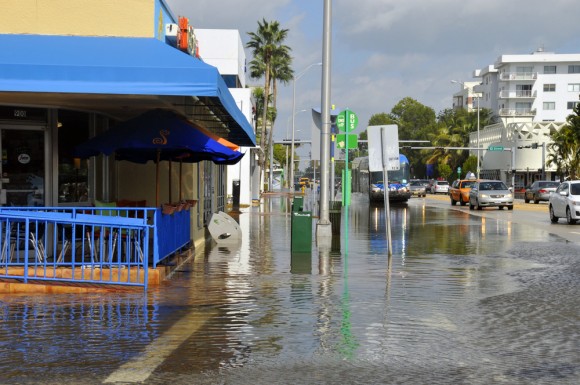The prospect of a delay in flood insurance reforms that are raising premiums for many homeowners is being met with pushback from business, taxpayer and insurance groups.
Rep. Maxine Waters, D-Calif., ranking member of the House Financial Services Committee, announced that Senate and House members have reached a bipartisan legislative fix for the National Flood Insurance Program (NFIP) that she said will assure that “changes are implemented affordably.”
The bipartisan deal calls for a four-year delay in implementation of reforms ordered by the Biggert-Waters Flood Insurance Reform Act of 2012.
Senators Mary L. Landrieu, D-La., Johnny Isakson, R-Ga., Robert Menendez, D-N.J., Jeff Merkley, D-Ore., Thad Cochran, R-Miss., Heidi Heitkamp, D-N.D., David Vitter, R-La., and John Hoeven, R-N.D., are among those sponsoring the legislation in the Senate.
But some interest groups hope lawmakers will stick with the Biggert-Waters reforms despite pressure to postpone them.
“We should be helping this law along, not pulling it out by its roots,” said Steve Ellis, vice president of Taxpayers for Common Sense, speaking at a media briefing today with Ceres, a nonprofit representing businesses and investors on climate issues that issued a new report today on the anniversary of Superstorm Sandy on the cost of to taxpayers federal disaster programs.
Ellis said that the NFIP was about $17 billion in debt when Biggert-Waters was passed in 2012, while it is now $25 billion in debt — proof that the current program in unsustainable.
Franklin Nutter, president, Reinsurance Association of America, also criticized the idea of a delay in the flood insurance reforms.
“It [the Waters’ bipartisan deal] effectively guts the reforms,” Nutter said. “It would be a remarkable and unfortunate turnaround for Congress to do this.”
Nutter urged Congress to create a transparent program to assist homeowners who can’t afford flood premiums rather than gutting all the reforms with what he termed a “blanket, club-like approach.”
Nutter said the four-year delay proposed by Waters— two years for an affordability study followed by two years of implementation of affordability provisions — would actually delay reforms beyond the authorization of the flood program, which is set to expire in September, 2017.
“Taxpayers should be outraged that their tax dollars are incentivizing high risk behavior that increases federal disaster costs,” said Ellis of the taxpayer group.
Ellis said Congress can create a means-tested relief option for homeowners but for lawmakers to delay Biggert-Waters on the assumption there are other solutions beyond charging risk-based premiums is “preposterous.”
The latest Ceres report highlights the cost to taxpayers of subsidies for flood-prone properties and farmers’ crop insurance and other federal disaster aid and chides policymakers for inaction on climate change.
“Taxpayer costs from climate change are getting bigger and bigger. Last year’s extreme weather events alone cost every American more than $300 apiece, or $100 billion altogether – most of it to pay for federal crop, flood, wildfire and disaster relief,” said Ceres president Mindy Lubber. “Yet, our public disaster relief and recovery programs have been slow to recognize that worsening climate impacts will drive up future losses to unsustainable levels. Instead of encouraging behavior that reduces risks from extreme weather events, these programs are encouraging behavior that increases these risks – such as agricultural practices that increase vulnerability to drought and new development in hurricane- and wildfire-prone areas.”
The report says taxpayers in hurricane-prone states like Florida and Texas are particularly vulnerable because many private insurers have withdrawn, leaving state-run insurance programs on the hook for insured losses from coastal storms. In the past 20 years, the total loss exposure of these state-run insurance plans has risen by 1,550 percent, from about $40 billion in 1990 to more than $600 billion in 2010, according to Ceres.
“What’s most troubling about these trends is that so little is being done to control these costs,” said Lubber.
The report, Inaction on Climate Change: The Cost to Taxpayers, includes a number of recommendations:
- improving transparency and accounting of the costs of extreme weather events to disaster relief and recovery programs;
- boosting research to understand how climate change will impact these programs; requiring recipients of federal relief and recovery assistance to adopt more stringent building codes and prohibit development in vulnerable areas;
- finding ways to increase the level of private insurance market participation to reduce pressure on government relief and recovery programs.
Today only about 50 percent of the damages in the U.S. caused by extreme weather events are privately insured, according to Ceres.
“The report shows that dealing with climate change doesn’t require large-scale schemes or a total restructuring of our global economy,” said Eli Lehrer, president of the R Street Institute, a nonprofit think-tank that advocates for free market solutions. “The ideas outlined here are the basis of a true ‘no-regrets’ strategy for dealing with a significant problem.”
Topics Legislation Flood Climate Change
Was this article valuable?
Here are more articles you may enjoy.



 Wildfires, Storms Fuel 2025 Insured Losses of $108 Billion: Munich Re Report
Wildfires, Storms Fuel 2025 Insured Losses of $108 Billion: Munich Re Report  10 Highest Class-Action Settlements in 2025 Eclipsed $70B Total: Duane Morris
10 Highest Class-Action Settlements in 2025 Eclipsed $70B Total: Duane Morris  Adjusters Launch ‘CarFax for Insurance Claims’ to Vet Carriers’ Damage Estimates
Adjusters Launch ‘CarFax for Insurance Claims’ to Vet Carriers’ Damage Estimates  Warburg Mulls $1 Billion Sale of London Insurance Broker McGill
Warburg Mulls $1 Billion Sale of London Insurance Broker McGill 

